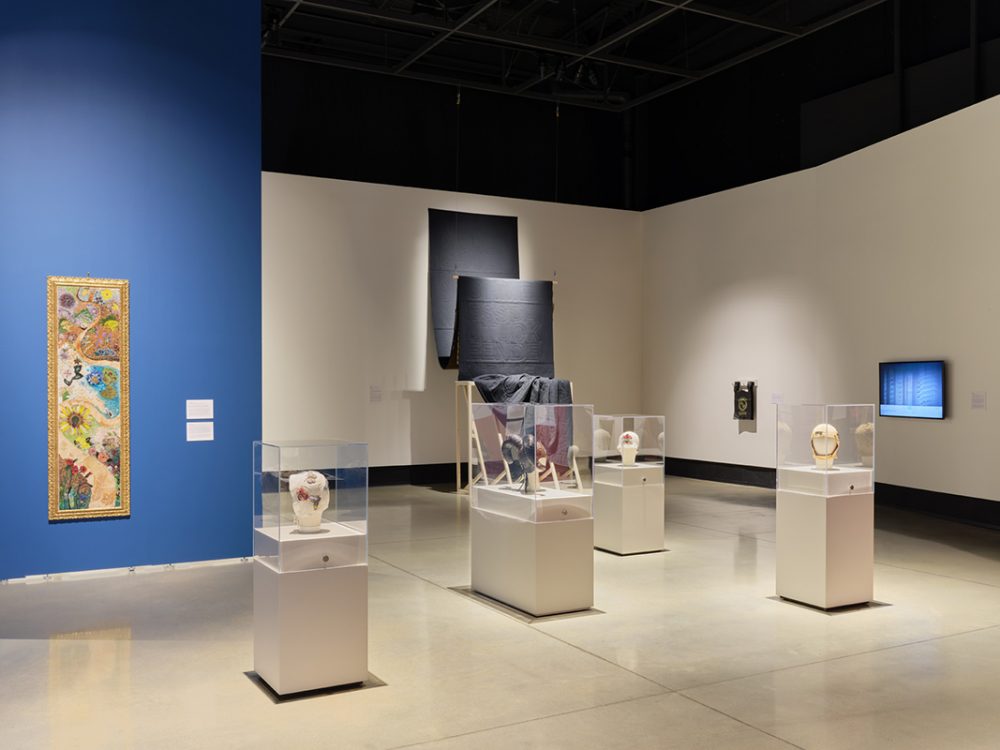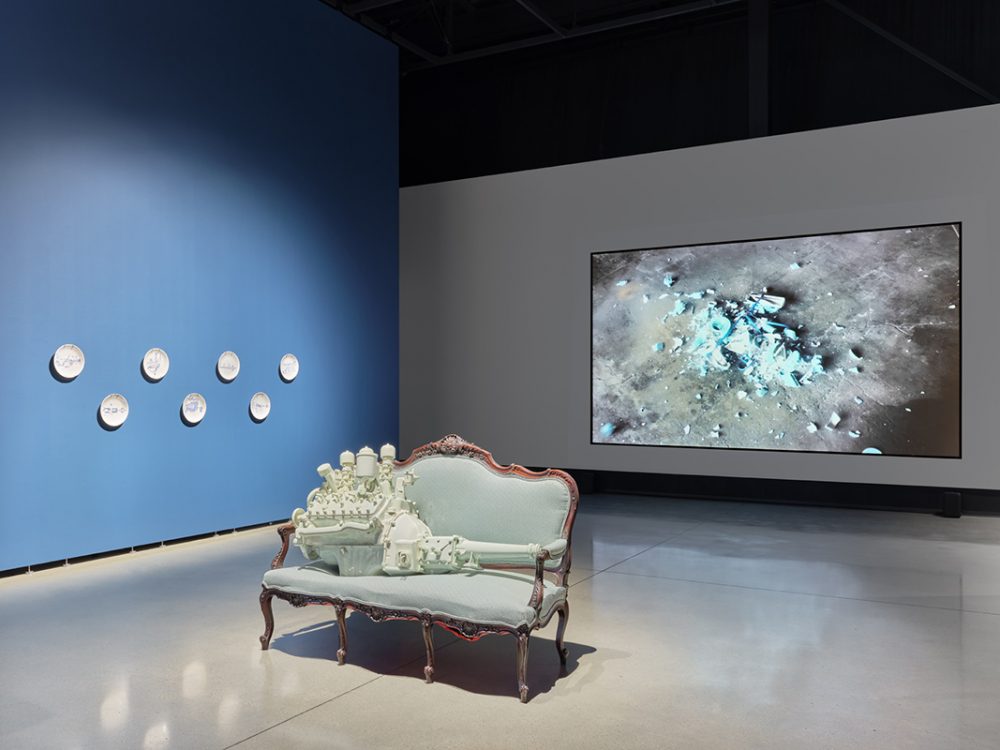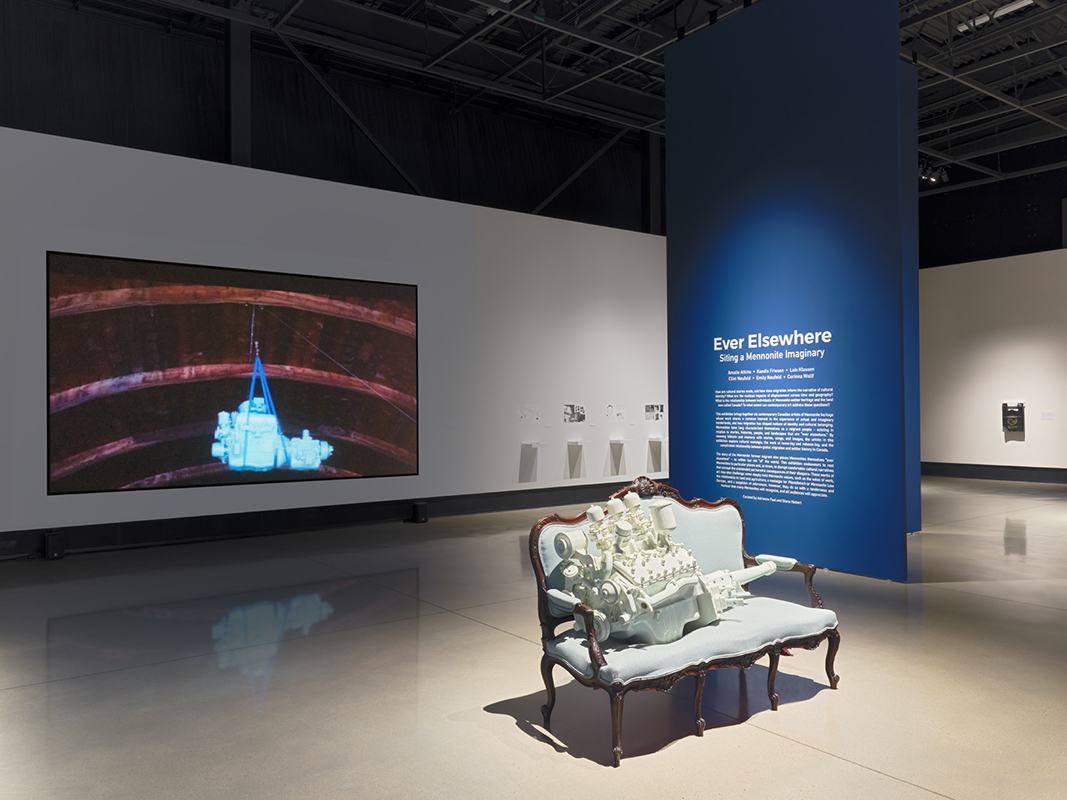New exhibit at The Reach looks at the migration and settlement of Mennonites in the Fraser Valley
Ever Elsewhere, an exhibition currently showing at The Reach Gallery Museum, features six contemporary Canadian artists of Mennonite heritage, bringing together a variety of multimedia pieces to explore the themes of migration and settlement within the Mennonite culture. The exhibition is curated by Adrienne Fast, curator of arts and visual culture, and Diana Hiebert, curator of learning and community engagement at The Reach. The Cascade spoke to the two curators to learn more about their own Mennonite heritage and growth as artists, the inspiration behind the exhibition, and how it all came together.
While Hiebert was completing her master’s degree in art history at Carleton University, she started inquiring into how artists of Mennonite heritage were operating in the field of contemporary art in Canada or Turtle Island (the name some Indigenous groups use for North America), and how this heritage came to bear on their work. Her curiosity stemmed from not being able to identify with anyone in the contemporary arts community, and she soon came to discover the myriad of Canadian Mennonite artists who were thriving in the field.
As for Fast, she had never thought about her relationship within the Mennonite community, and nobody had really asked her about this part of her life. Until, that is, she moved to the Fraser Valley in 2018 and got questioned about 10 times within the first week whether or not she is Mennonite because of her last name. All of these questions about her heritage gave Fast the idea of curating an exhibition made up of Mennonite artists. The executive director of The Reach, Laura Schneider, referred Fast to Hiebert, who had written her master’s thesis on contemporary Canadian artists of Mennonite heritage, to collaborate on the project.

Fast and Hiebert began talking to each other and to other Mennonite artists about their shared history of migration and settlement, and the constant movement of Mennonites around the globe in response to the oppression of their religion and culture. Fast and Hiebert were interested in finding artists whose work expressed some of the intangible aspects of cultural heritage that Mennonites carry with them as they move from place to place, whether that be agriculture, gender roles, language, costume, folklore, or pacifist beliefs. Also, Fast explained, they were looking for work that expressed the Mennonite relationship to land and home, being a people constantly on the move. They also wanted the exhibition to reflect the Fraser Valley’s Mennonite population and their experience as settlers in a land that was stolen from the original Indigenous inhabitants.
The exhibition features work by Kandis Friesen, whose pieces operate on many different levels. She has three different works in the exhibition, but the one that catches everyone’s eye is the massive quilt embroidered with the Plautdietsch phrase: “When all the shelters in the world come together, this too is also a shelter. When all the monuments in the world come together, this too is also a monument. When all the refrains in the world come together, this too is also a refrain.” This piece of work touches on the Mennonite traditional handicraft of quiltmaking, the distinct Mennonite language of Low German, and the almost sarcastic sense of humour known as the “loving insult.” In a panel discussion held with a few of the artists from the exhibition, Friesen described the distinct diasporic language of Plautdietsch (or Low German) as a language that has never been standardized and that changes from person to person. She identified this mother-tongue as a homeland in itself.
Emily Neufeld’s piece Motherlands is a sculptural installation inspired by her ancestors’ migration. She used deeply personal materials to create the piece, like the map illustrating her ancestors’ migration to Canada washed in dirt from her mother’s garden in Alberta, and even some of her own hair. By incorporating pieces of herself into the piece she played upon the memory of these migrations.
“The way we have been oppressed and having to constantly migrate because of that oppression makes us more empathetic, in a way, toward others who need to do the same,” said Neufeld in a panel discussion. “Refugees from land that has been given and taken, we were thrown out of places and were given places to live through others being pushed out of those places.”
Amalie Atkins’ work focused mainly on Mennonite folklore and storytelling. Her 25-minute film Requiem for Wind and Water tells the story of conjoined twin girls who work together to kill an evil witch as revenge for their mother’s death. The film is set on the rolling Canadian prairies, the newfound homeland of many Mennonite and Doukhobor groups immigrating from Russia. The almost sinister nature of her film reflects the trauma experienced by her immigrant ancestors brought on by continual, abrupt migration due to religious persecution. The twins kill their witch by luring her in with a spread of cakes and puddings, then stabbing her in the back with embroidery shears, playing with the Mennonite ideas of pacifism and feminine domesticity.
Fast and Hiebert expressed the fateful serendipity of Ever Elsewhere being placed side-by-side with the Semá:th Xo:tsa exhibition, something they had not originally planned. But due to COVID-19 disturbing all of the exhibition’s schedules, the two exhibitions ended up being shown at the same time. The gallery is laid out in a way that visitors are directed through the Semá:th Xo:tsa exhibition first, reading about the history of the draining of Sumas Lake. The settlers of the Fraser Valley campaigned to drain the lake in order to increase agricultural production, not taking into account the ecological diversity within the lake, or the spiritual, cultural, or practical significance the lake had among the Séma:th people. This exhibition helps give context to the Ever Elsewhere exhibition, which grapples with the history of some of those settlers, the Mennonite community. The juxtaposition of the two exhibitions creates a dialogue about different cultural attitudes toward relationship to the land — how the Indigenous concept of land stewardship and being protectors of the land compares with the Mennonite idea that you claim the land by working it.

“Mennonites might say that they came here, they worked hard and were able to succeed,” said Fast, “but [we’re] trying to draw this connection that our success is also based on someone else’s persecution. Just because we have faced persecution ourselves does not mean that we aren’t also complicit in these larger systems that operate in places like Canada.”
The curators also expressed the concern they felt in the wake of the resurgence of the Black Lives Matter movement this summer, and questioned whether or not the world needs an exhibition of mostly white, Mennonite artists right now. Part of the reason why they ultimately went ahead with the exhibition was because of the opportunity to pair it with the Semá:th Xo:tsa exhibition.
When asked what the main point they want visitors to take away from this exhibition or learn from it is, the curators had this to say:
“I feel like the centre is really storytelling: how we tell stories, what things we pick up and pull to create our own stories to shape who we are and our actions,” said Hiebert.
Fast expressed how curating the exhibition has helped her think about some of the Mennonite characteristics she has seen within herself and her own family, despite the fact she was not raised in the church.
So, what advice would these curators give to up-and-coming artists, or for those who are discouraged from the negative feedback they’ve gotten from their conservative families?
“You know yourself and you know what makes you come alive,” said Hiebert. “There are so many skills that are transferable in the arts, like creative problem solving; there are so many things that apply that I have found useful in my own life. Obviously, right now is a difficult time in many, many different ways, especially if you’re just coming out of art school … but if it’s a part of who you are, you’ll find ways to continue to carry on and continue creating.”
Fast remembered what some of the artists’ had said in their panel discussion about the exhibition. Atkins in particular recalled that everything her grandmother did was a performance, whether it be setting the table, cutting a watermelon, or frying perogies.
“There were always creative practices happening; it’s only been in the last couple of generations that young people in Mennonite communities felt like they could filter that through art school,” said Fast. “I truly believe that looking at art and talking about art and thinking about art makes better people. I think it makes better neighbours, it makes better communities — it’s the thing that I see bridging a connection between human beings that feel like they have nothing in common with each other.”
Check out the Ever Elsewhere exhibition at The Reach Gallery Museum running until Jan. 9, 2021.
Ever Elsewhere Exhibition. (Rachel Topham Photography)
(Note: this article previously erroneously credited the photos to Rachel Tomphan.)
Andrea Sadowski is working towards her BA in Global Development Studies, with a minor in anthropology and Mennonite studies. When she's not sitting in front of her computer, Andrea enjoys climbing mountains, sleeping outside, cooking delicious plant-based food, talking to animals, and dismantling the patriarchy.


